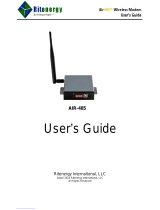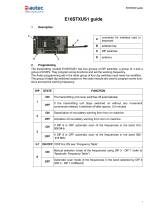
9XCite‐PKG‐R™RS‐232/485RFModem–ProductManualv2.1[2007.01.04]
©2007MaxStream,Inc. 15
3.2.4. Sleep Modes
Software Sleep
Sleep Modes enable the modem to enter states of low-power consumption when not in use. Three
software Sleep Modes are supported:
• Pin Sleep (Host Controlled)
• Serial Port Sleep (Wake on Serial Port activity)
• Cyclic Sleep (Wake on RF activity)
In order to enter Sleep Mode, one of the following conditions must be met (in addition to the
modem having a non-zero SM parameter value):
Once in Sleep Mode, the radio modem does not transmit or receive data until it first returns to Idle
Mode. The return into Idle Mode is triggered by the de-assertion of the Sleep pin or the arrival of a
serial byte through Data In pin.
The SM (Sleep Mode) command is central to setting all Sleep Mode configurations. By default,
Sleep Modes are disabled (SM = 0) and the modem remains in Idle/Receive Mode. When in this
state, the modem remains constantly ready to respond to serial or RF activity.
Pin Sleep (SM = 1)
• Pin/Host-controlled
<Lowest Power Configuration> In order to achieve this low-power state, Pin 2 must be asserted
(high). The modem remains in Pin Sleep until the Sleep pin is de-asserted. The modem will com-
plete a transmission or reception before activating Pin Sleep.
After enabling Pin Sleep (SM (Sleep Mode) Parameter = 1), Pin 2 controls whether the XCite Mod-
ule is active or in Sleep Mode. When Pin 2 is asserted (high), the modem transitions to Sleep Mode
and remains in its lowest power-consuming state until the Sleep pin is de-asserted. The XCite
Module requires 40ms to transition from Sleep Mode to Idle Mode. Pin 2 is only active if the
modem is setup to operate in this mode; otherwise the pin is ignored. Once in Pin Sleep Mode,
CTS
is de-asserted (high), indicating that data should not be sent to the modem. The PWR pin is
also de-asserted (low) when the modem is in Pin Sleep Mode
Note: The modem will complete a transmission or reception before activating Pin Sleep.
Serial Port Sleep (SM = 2)
• Wake on serial port activity
Serial Port Sleep is a Sleep Mode setting in which the modem runs in a low power state until data
is detected on the DI pin.
When Serial Port Sleep is enabled, the modem goes into Sleep Mode after a user-defined period of
inactivity (no transmitting or receiving of data). This period of time is determined by ST (Time
before Sleep) Command. The modem returns to Idle Mode once a character is received through
the DI pin.
Cyclic Sleep (SM = 3-8)
Cyclic Sleep is the Sleep Mode setting in which the XCite Module enters into a low power state and
awakens periodically to determine if any transmissions are being sent.
When Cyclic Sleep settings are enabled, the XCite Module goes into Sleep Mode after a user-
defined period of inactivity (no transmission or reception on the RF channel). The user-defined
period is determined by ST Parameter. [See ST (Time before Sleep) Parameter]
While the modem is in a low-power state, CTS
de-asserted (high) to indicate that data should not
be sent to the modem during this time. When the modem awakens to listen for data, CTS
is
asserted and any data received on the DI Pin is transmitted. The PWR pin is also de-asserted (low)
when the modem is in Cyclic Sleep Mode. These pins are asserted each time the modem cycles
1. The modem is idle (no data transmission or reception) for the amount of time defined by
the ST (Time before Sleep) parameter.
2. SLEEP pin is asserted.
























